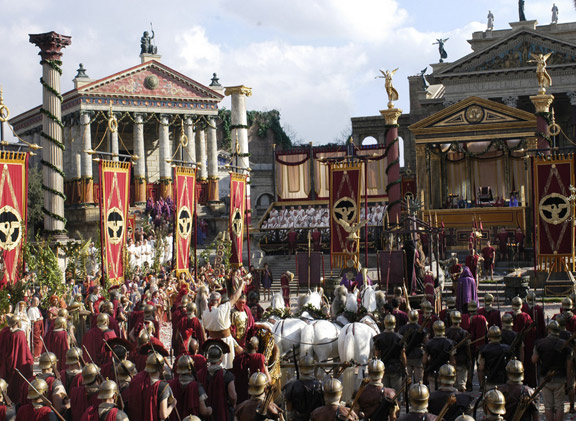
HBO’s Rome is a richly layered, gloriously appointed drama set in antiquity, boasting a Cecil B. DeMille exactitude tradition, filmed in Italy, and upholding the historical context of its setting. When in HBO’s Rome, revenge is laudable, something like underwear is optional, and gods, dirt, graffiti, slaves and blood are everywhere. How respectfully did HBO add a sense of the real?
If you’ve watched the series (both seasons are now available on DVD), you’d remember Lucius Vorenus and Titus Pullo (Kevin McKidd and Ray Stevenpon) and the upstairs-downstairs bifurcations in the narrative that drove these two centurions through the downfall of the Republic to the rise of the dread Roman Empire. You’d also remember commendatory performances, resplendent cityscapes, a male slave with a bloated and gaudily decorated phallus (a single, unforgettable moment in which Atia of the Julii attempts to placate one of her enemies with the gift of big love), clay jars filled with ash, swagger, fire, aqueducts, death by garroting, fruits and meat hanging from hooks, smoke stains on the hearthstone, and sadistic and violent acts of pater familias.
Last Thursday, The Getty welcomed us to the Second Annual Villa Council Lecture made possible by the Villa Council, one of a triumvirate who rose to take bows (and rightly) for making this possible. At stake, nothing short of pushing the craft and creating glimpses of historical fiction from the point of view of the entertainment industry. Jonathan Stamp, historical consultant for Rome, geeky, gawky, spirited and British, took his seat next to Pulitzer Prize-winning journalist, author and commentator Patt Morrison for a go-round on whether accurate portrayals are even possible in Hollywood.
“I think the first thing to get straight is that it’s not educational philanthropy. It’s entertainment. It’s the entertainment business,” Mr. Stamp began. You’ll note the flash of steel. “That’s the reason that people go back to the past. They think it’s a very rich scene to find stories that will entertain mass audiences. I think that’s also — there’s a view in some people — that the past or the study of the past in the mass media is a way of commenting on the present. So you could say there’s a little higher purpose there, too. If you wanted to.” He outlined his case that the leading impulse in dealing with “something that really happened”, at least in Hollywood, is to represent whatever period faithfully, but not accurately.
Wearing a black beret (I think she is known for her hats), and quipping, Ms. Morrison tried to focus on many faithful historical inaccuracies while audience laughter died down. When he mentioned James Cameron’s Titanic, for example, as the most successful grossing instance of “historical branding”, Morrison reminded us, for starters, that the movie took longer than the ship to sink. That put him on the defensive. Stamp replied, “I did not say that Titanic is a shining example of historical veracity on film because it absolutely isn’t. Not at all. No, I don’t mean that. I think it’s that if you can say that the details are right, that it adds value… it’s really important to be clear that, particularly with a big undertaking like Rome, that the real motivation is to entertain people, to draw people in It’s the primary mode. It’s not to educate people.”
He added, “You want to get bums on seats.”
From that point, Patt Morrison moderated an erudite and fully enjoyable discussion loaded with wry observations, laughter, and classic culture. Here’s a few highlights:

SPARTACUS
“To suggest that it’s a representation of life in 71 B.C. would be… stretching it.” (Laughter.)
Stanley Kubrick needed to get the sandals right in Spartacus but the actual story, written by blacklisted Spartacus-in-residence Dalton Trumble, is for the times they lived in. The real Spartacus died in battle prior to the movie’s famous “I am Spartacus” outing scene, an unfortunate historical fact. But the power of that scene is seeing all the people stand up and support him, the opposite of Trundle’s experience. A sophistic distinction?
EGYPTIANS ON MOVIE SETS
Morrison asked him, “What about [Golden Age] studio films? Historical films by Cecil B. DeMille? If an Egyptian were to wander onto one of his sets, would he recognize it?” No. DeMille’s research was not into ancient Egypt but in romanticized nineteenth century representations of ancient Egypt, a very important distinction. Ptolemy would have felt he was on the planet Laurence Alma-Tatema, the artist who unwittingly gave early Hollywood his visions, color and compositions.

BRAVEHEART
Stamp credits Braveheart as the film that set the way and restarted the big-scale historical film, yet holds Mel Gibson in contempt for twisting its portrayal of William Wallace into Anglophobic rants that Scottish citizens quoted as an example of the high principles of Scottish nationalism at a time when many were pressing for a devolved Scotland. “It’s more that that film combined a whole lot of things that make you uneasy about the use of the past and, again, this is a very emotive word, but it’s effectively a propagandistic use of the past. Increasingly, you are putting these movies out in front of audiences, particularly younger audience, who have much less of a framework and a reference than they used to have for judging whether or not something is true. We’ve had less of a sense of narrative history than we’d had. The imaginative impact that a good movie scene has upon you whether it’s accurate or not goes into a different part of you. You don’t just process it’s read, it somehow becomes part of you. The Braveheart nationalism is a good example of that.”
RAZOR BLADES ON THE NIPPLES OF FEMALE GLADIATORS
“I was fortunate again because I did get invited to join the (Rome) process in the early stage, and also the team was incredibly collaborative and was willing, wanting, hungry for historical detail and information and so on. I didn’t have to push against anything. But I know of other people who were simply used to be a credit at the end of a movie so it would say, ‘Ah, that’s historically legitimate.’” Evidently, a Harvard Latin professor removed her name from Gladiator because the art designer wanted an historical reference to justify that female gladiators had razor blades on their nipples. “Ah, yes. That’s in the Letters to Cicero,” Stamp said. “Indexed under razor blades,” Morrison added.
EXAMPLE OF BAD HISTORICAL DIALOGUE
“Saddle the camels, we ride for Luxor tonight!”
SHAKESPEAREAN FIRST SCENE AMNESIA SOLVING THE PROBLEM OF EXPOSITION
“Remind me again why I’m so unhappy.” It’s your father, the king. “Oh, right, right.”
ON AUTHENTICITY VERSUS ACCURACY
“You have to take liberties with the historical record because you’re constructing stories which are meaningful and to which your audience can respond. That is your primary obligation as an entertainer and a storyteller. What you CAN be is authentic, by which I mean you can try to get the details right: gesture, hair, costume, architecture, color, movements, dynamism and interaction, performance. All of those things you can inform as a consultant and you can offer your help on and it can be accepted if its helpful or quarreled with if it is disagreed with, or whatever else. But that is your job: to help provide a world that is authentic. An authentic world is a coherent world; it feels like it all hang together.”
“Another thing about the authenticity of detail is the ways in which it can help performance. It might give you a MacGuffin, a little thing, that helps you concentrate and focus what you are doing. You put someone is a big Roman house, like one of the rooms [at the Getty Villa] and say you’ve just come back from a hard day in the Senate, it doesn’t compute. There’s nothing to refer to. And that’s where the authenticity, the detail work, comes in. There may be a specific bit of detail that you can throw out there and an actor will say that’s useful, that works for me.”
MISTAKES, I’VE MADE A FEW
“Octavia quotes Virgil’s sixth book of the Aeneid about thirty years before it was written.”
“There is a parrot was not imported to Europe until 1896 from the Tierra del Fuego. I got one letter from the ornithological society in London, and it was a long, long letter I had to wade through, that ended with the immortal line, ‘We regret to inform you that you have lost the confidence of the British Bird Watching Society.’”
CELL PHONES IN THE COLOSSEUM
It was a big issue on set working with Italian extras. The Italians are used to post-dubbing everything so they’re not that respectful of sound on set. So you could have an extra with his cell phone under his tunic and it would go off and he might even answer it. ‘Pronto, Pronto!’”

KNIVES OUT
In the audience were professors of Archaeology, Classics and Ancient Religion at variance with Mr. Stamp’s authenticity-favoring “bums on seats” defense. Jonathan Stamp has won three Emmys in addition to his scholarly distinctions but moonwalked when engaging very specific insights, bringing up those who did it worse (Mel Gibson’s Braveheart) or more shamelessly admitting “guilty as charged” rather than go five more rounds with a PhD. Among the more compelling observations came from Dr. Kathryn J. McDonnell, Classical Archaeology at UCLA, who had argued previously with Stamp in a bar in Schenectady about the difference between authenticity and merely “meeting audience expectation, and where authentic details fit modern preconceptions about the Romans.” She points out that Caesar’s face is properly painted red during his triumph, but later in the series, Octavian’s face is not. Mea culpa. A visiting French professor specializing in Roman Religion finds no evidence of any human blood-letting rituals in private worship as depicted on the show, and did not wish to compete with an eye-grabbing show like Rome. And Stamp sympathized.
THINGS I OMIT FROM THIS REVIEW
I am omitting an oblique comparison between Lucius Vorenus/Titus Pullo and See-Threepio/R2D2. I do not think it fits into the overall context in which the information has been offered up.
Upcoming Getty Center and Getty Villa Events Calendarhere.

